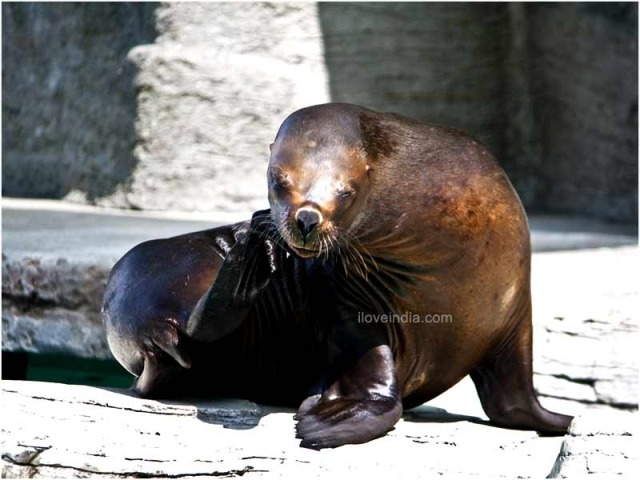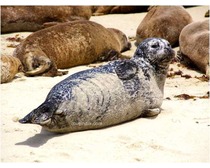Pinniped is a semi-aquatic mammal, with 33 known species and a drum-like body. Read on to find some more interesting facts & amazing information on this animal.
Facts About Pinniped
The term ‘pinniped’, in Latin, means wing- or fin-footed and is used to describe fin-footed mammals. Pinniped is a group of 33 species of semi-aquatic mammals, comprising of seals, sea lions, and the walrus. These mammals live in rich marine environments and a few inland or tropical freshwater systems. The family of pinniped includes Otariidae (eared seals, including sea lions and fur seals), Odobenidae (the walrus), and Phocidae (earless seals). The discovery of oldest fossil of Puijila, its ancestor, in Canada reveals that it evolved some 23 million years ago, from a bear-like ancestor. Pinnipeds found the world over possess drum-shaped sleek body that can be large too. They love water and are great swimmers. Read on to know some more interesting facts and amazing information on pinniped.

Facts About Pinniped
Kingdom: Animalia
Phylum: Chordata
Subphylum: Vertebrata
Class: Mammalia
Order: Carnivora
Family: Caniformia
Superfamily: Pinnipedia
Subfamily: Odobenidae (walruses), Otariidae (fur seals and sea lions), Phocidae (true seals)
Height: small- 1.2 m (4 ft) long/ large- 4 m (13 ft) long
Weight: small- 30 kg (65 lb)/ large- 2,200 kg (4,850 lb, more than 2 tons)
Life Span: male: 30- 35 years/ female: 20-25 years
Diet: Strictly carnivorouseats fish, shellfish, squid, and other marine creatures
Range: Subtropics of China, zoos around the world
Habitat: aquatic, beach, sea ice
Age of Sexual Maturity: male: 4- 8 years/ female: 5- 7 years
Gestation Period: 8 to 15 months
Number of Offspring: 1 or 2 (rarely)
Interesting & Amazing Information On Pinnipeds
- Pinniped are fin-footed mammals that are well adapted to aquatic habitat, in which they spend most of their lives.
- They are mammals, because they possess five traits of mammals - they breathe air, give live birth, have warm blood (maintain a high and constant body temperature independent of the surroundings), nurse young ones and have hair.
- Pinnipeds dwell on both land and sea. They live, find their food in sea, hence are grouped as semi-aquatic marine animals.
- These mammals come ashore once in each year, usually in springtime and gather on beaches or sea ice, to give breed and birth.
- After the pupping season, adults often come on shore to shed the outer skin layers with old fur and hair. They even bask in sun throughout the year.
- The limbs of pinniped grow into short, wide, flat flippers that allow them to move through water.
- In Phocidae sub-species of pinniped, the two back flippers have evolved into a tail-like structure that cannot be used for walking on land.
- The fingers and toes of pinniped are bound together by a web of skin.
- Pinnipeds become weightless in water, as water has much higher density than their body. This allows them to stand still in water and perform aquatic deeds.
- These mammals can save oxygen in water, for a long period of time. In addition, they can hold their breath under water for atleast 2 hours.
- The heart rate of pinnipeds, while diving, slows down to nearly one-tenth of the normal rate. Moreover, only their nervous system and sense organs have a normal flow of blood, during that time.
- The eyes of pinnipeds are excellently covered with a membrane that protects and covers the eyes. It also allows them to see both above and below water.
- The male pinnipeds of many species, like elephant seals, South American sea lions, and Northern fur seals, guard groups of specific females, referred to as harems.
- In species like sea lions and brown fur seals, the male pinnipdes defend territories on reproductive rookeries, while females move freely between them.


See also
More from iloveindia.com
- Home Remedies | Ayurveda | Vastu | Yoga | Feng Shui | Tattoos | Fitness | Garden | Nutrition | Parenting | Bikes | Cars | Baby Care | Indian Weddings | Festivals | Party ideas | Horoscope 2015 | Pets | Finance | Figures of Speech | Hotels in India : Delhi | Hyderabad | Chennai | Mumbai | Kolkata | Bangalore | Ahmedabad | Jaipur
- Contact Us Careers Disclaimer Privacy Policy Advertise With Us Lifestyle Sitemap Copyright iloveindia.com. All Rights Reserved.




